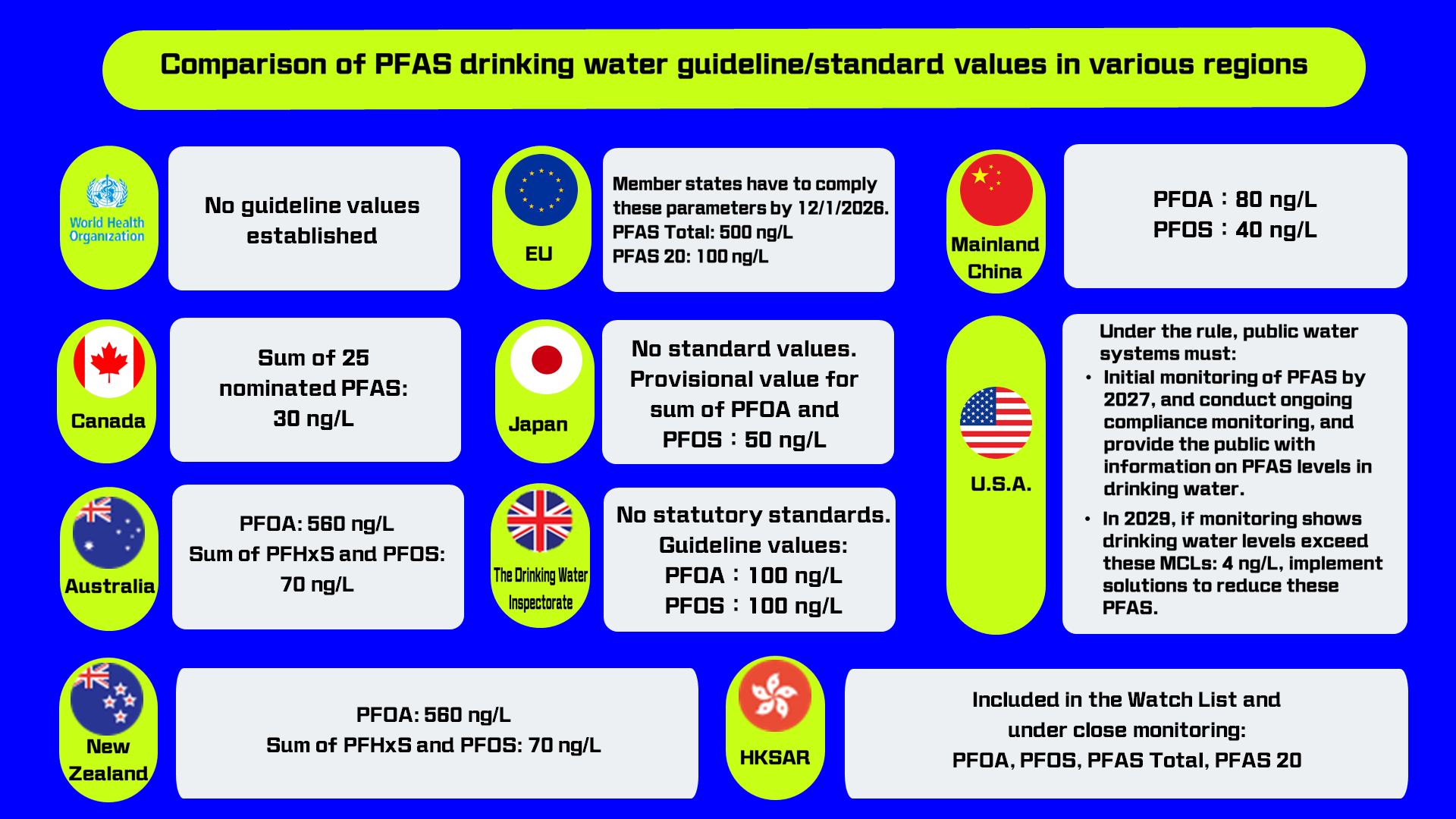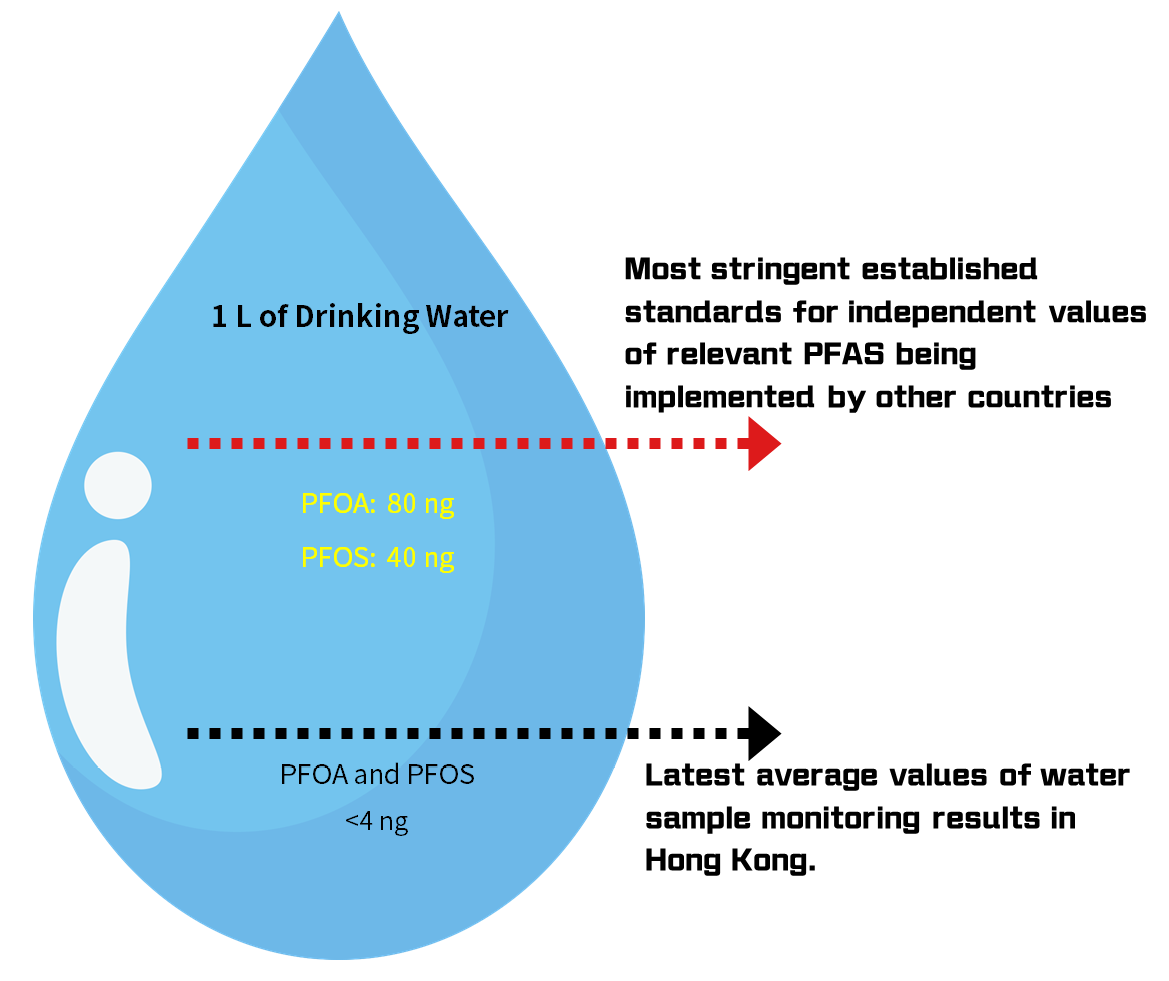

Note : PFAS 20= "Sum of 20 PFAS" including Perfluorobutane sulfonic acid (PFBS), Perfluorobutanoic acid (PFBA), Perfluorodecane sulfonic acid (PFDS), Perfluorodecanoic acid (PFDA), Perfluorododecane sulfonic acid (PFDoDS), Perfluorododecanoic acid (PFDoDA), Perfluoroheptane sulfonic acid (PFHpS), Perfluoroheptanoic acid (PFHpA), Perfluorohexane sulfonic acid (PFHxS), Perfluorohexanoic acid (PFHxA), Perfluorononane sulfonic acid (PFNS), Perfluorononanoic acid (PFNA), Perfluorooctane sulfonic acid (PFOS), Perfluorooctanoic acid (PFOA), Perfluoropentane sulfonic acid (PFPS), Perfluoropentanoic acid (PFPA), Perfluorotridecane sulfonic acid (PFTrDS), Perfluorotridecanoic acid (PFTrDA), Perfluoroundecane sulfonic acid (PFUnDS) and Perfluoroundecanoic acid (PFUnDA).
Hong Kong Drinking Water Standards ("HKDWS")
According to WHO guidelines, individual countries/regions must consider local environmental, social, cultural, economic, dietary, and other conditions when establishing drinking water standards to set up a set of water standards suitable for the local situation. Currently, places that have established PFAS standards include Mainland China, Australia, New Zealand, the European Union, Canada, and the United States. Each region adopts specific PFAS parameters and standards values according to its own situation. For example, Mainland China, Australia, and New Zealand set independent standard values for individual PFAS (related PFOA standard values ranging from 80 nanograms per liter to 560 nanograms per liter; PFOS standard values ranging from 40 nanograms per liter to 100 nanograms per liter), while the European Union and Canada set a total standard value for a basket of PFAS. The United States adopts both approaches simultaneously. The U.S. standard is not widely adopted internationally, and when relevant standards are issued by U.S. authorities, a 5-year grace period is provided, meaning that the standards will only be officially implemented in 2029.
The HKDWS are established based on an assessment framework, which includes assessing the likelihood of contaminants being present in Hong Kong's drinking water and the associated health risks. During the review of the "Hong Kong Drinking Water Standards" in 2023, independent experts analyzed local monitoring data and concluded that the risk of PFAS in Hong Kong's drinking water is extremely low. Therefore, they recommended that PFAS should not be included in the "Hong Kong Drinking Water Standards" and should remain on the Watch List. This recommendation was also discussed and confirmed by the Drinking Water Safety Advisory Committee.
Water Quality Monitoring Results

The WSD has been monitoring the levels of PFAS in drinking water since 2013, and all test results have shown that the levels of PFAS in Hong Kong's drinking water have remained extremely low. For example, the latest monitoring results of drinking water samples in Hong Kong for two of the most common PFAS, namely perfluorooctanoic acid (PFOA) and perfluorooctane sulfonate (PFOS), showed an average values of <4 nanograms per liter, which are far below the standards established by countries that have implemented independent standard values for relevant PFAS (the most stringent standard value for PFOA is 80 nanograms per liter; for PFOS, it is 40 nanograms per liter). Independent experts from the WSD have also analyzed the latest data on PFAS in Hong Kong for 2024 and concluded that drinking water in Hong Kong is safe.